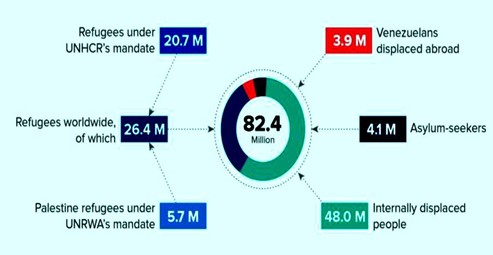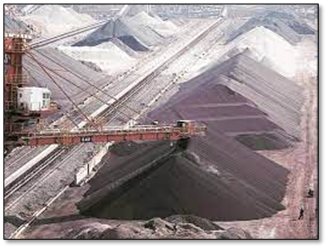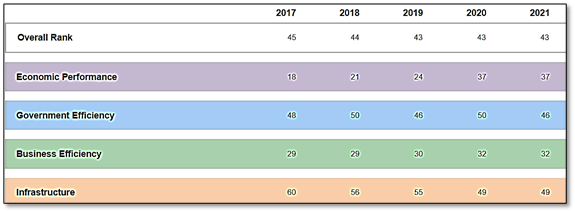Thursday, 24th June 2021
Recusal of Judges - Edukemy Current Affairs
In News
Recently, two Supreme Court judges have recused themselves from hearing cases relating to West Bengal.
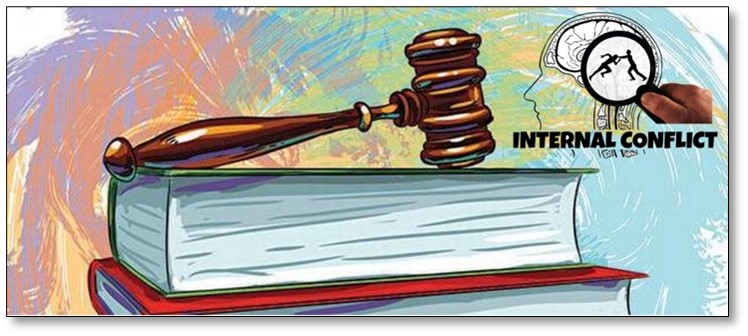
About the News
- The case pertains to a sting operation caught on camera, allegedly showing Trinamool Congress leaders accepting bribes. The TMC leaders have denied the charges.
- While one of the two judges expressed “personal difficulties” in taking up a clutch of petitions related to post-poll violence in the state, the other judge did not disclose the reason.
What is Recusal of Judges and why it is practised?
- Meaning of Recusal: The doctrine of judicial recusal enables and may require a judge who is lawfully appointed to hear and determine a case to stand down from that case, leaving its disposition to another colleague or colleagues.
- Reasons for Recusal: When there is a conflict of interest, a judge can withdraw from hearing a case to prevent creating a perception that she carried a bias while deciding the case. The conflict of interest can be in many ways, from holding shares in a company that is a litigant to having a prior or personal association with a party involved in the case.
- Origins of the Practice: The practice stems from the cardinal principle of due process of law that nobody can be a judge in her own case. Any interest or conflict of interest would be a ground to withdraw from a case since a judge has a duty to act fair. Another instance for recusal is when an appeal is filed in the Supreme Court against a judgement of a High Court that may have been delivered by the SC judge when she was in the HC.
- Rules for Recusal: There are no written rules on the recusal of judges from hearing cases listed before them in constitutional courts. It is left to the discretion of a judge. The reasons for recusal are not disclosed in an order of the court. Some judges orally convey to the lawyers involved in the case their reasons for recusal, many do not. Some explain the reasons in their order. The decision rests on the conscience of the judge.
- Process of Recusal: Once a request is made for recusal, the decision to recuse or not rests with the judge. While there are some instances where judges have recused even if they do not see a conflict but only because such an apprehension was cast, there have also been several cases where judges have refused to withdraw from a case.
- Need for transparency: In a landmark verdict in 2015 holding that the National Judicial Appointments Commission as unconstitutional, judges had referred to the need for judges to give reasons for recusal to build transparency and help frame rules to govern the process.
Sources: https://www.thehindu.com/news/national/when-can-a-judge-opt-out-of-a-case/article30831685.ece
https://indianexpress.com/article/explained/how-judges-recuse-from-cases-and-why-7371106/
Delimitation in Jammu and Kashmir
In News: The Union government has invited political leaders from Jammu and Kashmir for a meeting with the Prime Minister possibly regarding scheduling of the Assembly elections. For political process to kick-start in Jammu and Kashmir, delimitation stands crucial.
What is delimitation and why is it needed?
- Delimitation is the act of redrawing boundaries of a State Assembly seat or Lok Sabha seat to represent changes in population with respect to a recent census.
- This exercise is carried out by Delimitation Commission, whose orders have the force of law and cannot be questioned before any court.
- The objective is to redraw election seat boundaries in a way so that the population of all seats is the same throughout the state (equal representation at assembly level/same competition at all assembly seats).
Delimitation- Historical Background
- According to Article 82 of the Constitution, the Parliament enacts a Delimitation Act after every Census. Once the Act is in force, a Delimitation Commission is set up by the Union government.
- The States get redivided into territorial constituencies after every census as per Article 170 of the Constitution.
- Delimitation Commissions have been set up four times in the past in 1952, 1963, 1973 and 2002 under the Acts of 1952, 1962, 1972 and 2002 (there was no delimitation after 1981 and 1991 Censuses).
Delimitation in J&K
- Delimitation exercises in J&K in the past have been slightly different from those in the rest of the country because of the region’s special status (scrapped in August 2019).
- Until 2019, delimitation of Lok Sabha seats in J&K was governed by the Constitution of India, but the delimitation of the state’s Assembly seats was governed by the J&K Constitution and J&K RPA, 1957.
- Assembly seats in J&K were delimited in 1963, 1973 and 1995.
- The last exercise was conducted by the Justice K K Gupta Commission when the state was under President’s Rule and was based on the 1981 census, which formed the basis of the state elections in 1996.
- There was no census in the state in 1991 and no Delimitation Commission was set up by the state government after the 2001 census as the J&K Assembly passed a law putting a freeze on the fresh delimitation of seats until 2026.
Current Status around J&K
- After the abrogation of J&K’s special status in 2019, delimitation of Lok Sabha and Assembly seats in the newly created Union Territory would be as per the provisions of the Indian Constitution.
- A special delimitation commission was constituted on 6th March 2020 to carve out Assembly and Parliament seats in the UT.
- Although the Commission was tasked to finish delimitation in a year, it was granted a year’s extension due to the Covid crisis.
Primary source: https://indianexpress.com/article/explained/delimitation-in-jk-how-why-pm-modi-jammu-kashmir-leaders-meeting-special-status-7369580/
Process Safety Management (PSM) in Industries
According to a new report, there have been no improvements in process safety regulations in industries across India even since Bhopal gas tragedy of 1984.
PSM trends in India
- Process safety regulations are an integral part of maintaining the safety of workers, the public, and the environment.
- India continues to witness industrial hazards and accidents despite stringent regulations on process safety in Industries (refer infographic).
- Several accidents have occurred in chemical and active substance processing factories during the last two years in which several workers have died.
- For instance, on May 11, 2021, a massive fire broke out at the Venkat Narayan Active Ingredients Pvt Ltd (VNAI)’s bulk drug chemical unit. After the country-wide lockdown from March 2020-March 2021, more than 12 such industrial accidents have occurred.
- Continued industrial accidents are attributed to poor leadership of Safety integrated Process Operation, very limited risk based proactive approach to process safety, poor Skill development Plans for Safe Operation of the Process, and lack of awareness on part of workers and contractors.
Elements of PSM
- Process hazard analysis (PHA): The PHA is thorough, orderly, systematic approach for identifying, evaluating, and controlling hazards of processes involving hazardous chemicals.
- Operating procedures and safe practices: The employer must develop and implement written operating procedures that provide clear instructions for safely conducting activities in the plant.
- Process safety information: It compiles information on all hazardous chemicals employed or produced by the process and the technical information on systems and equipment used.
- Management of change (MOC): A change in the process system, change to an existing equipment, etc. must be well thought out, thoroughly evaluated, appropriately approved.
- Quality assurance (QA): All parts, equipment, controls, etc. associated with a system are assessed against the engineering standards before they are physically accepted.
- Training and performance: All employees must be adequately trained to execute their responsibilities. Employees’ performance must be monitored closely with regular feedback.
- Incident investigation: Whenever a safety incident is reported in the plant, a thorough investigation must be necessitated to determine the root causes for an incident.
- Emergency planning and response: If, despite the best planning, an incident occurs, it is essential that emergency pre-planning and training make employees to execute proper actions.
- Auditing: Regular safety audits and compliance audits must be conducted on all activities, procedures, equipment, and systems in the plant.
Conclusion
Ethically, providing a safe, reliable and a healthy work environment is a mandatory item for organizations. Such an environment certainly promotes a happy workplace and increases the productivity of employees. The best possible way of having a safe work environment is by eliminating hazards. Therefore, safety culture and safety barriers must be developed to keep the workplace safe, reliable, and healthy.
Note: Elements of PSM can also be used as way forward for any similar hazard prevention question on any other topic.
https://www.linkedin.com/pulse/process-safety-management-india-pannalal-soni
https://www.slideshare.net/PANNALALSONI/process-safety-management-in-india-119003536
Tourism and Covid-19
In News
With states beginning to ease restrictions and vaccination rates expected to improve, the domestic travel is picking up slowly and the tourism industry is likely to reach 35-40 per cent revenue of the pre-pandemic level in the current financial year, as per a Crisil Ratings Report.
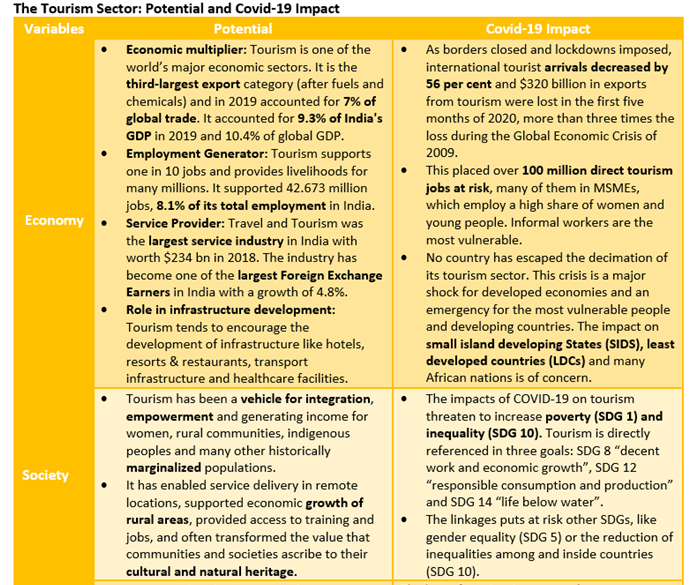
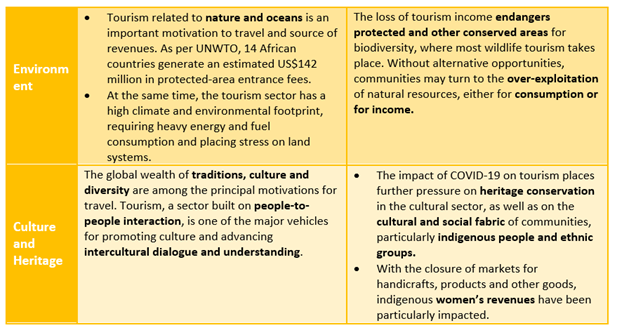
Roadmap to Build Back Better
- Manage and Mitigate the Crisis: Gradual and coordinated solutions and responses will have to be implemented to protect livelihoods, jobs, income and enterprises; build confidence through safety and security in all tourism operations; and strengthen partnerships and solidarity for socioeconomic recovery, prioritising inclusiveness.
- Advance Innovation and Digitalization of the Tourism Ecosystem: Recovery packages and future tourism developments could maximize the use of technology in the tourism ecosystem, promote digitalization to create innovative solutions and invest in digital skills, particularly for workers for job seekers.
- Foster Sustainability and Inclusive Green Growth: It is important for tourism to shift towards a resilient, competitive, resource efficient and carbon neutral sector, in line with the objectives and principles of the Paris Agreement on Climate Change. Financial and bailout support from governments to the accommodation, cruise and aviation industries could also ensure unsustainable polluting practices are banned.
- Coordination and partnership to transform Tourism: More agile approaches and alliances will be required for moving towards a resilient future and global goals. Effective coordination for reopening and recovery plans and policies could consider putting people first, involving government, development partners and international finance institutions for a significant impact on economies and livelihoods. The UNWTO members signed the Tbilisi Declaration, which recognizes the importance of tourism to livelihoods, to economic prosperity and opportunity, and to preserving our shared and unique culture.
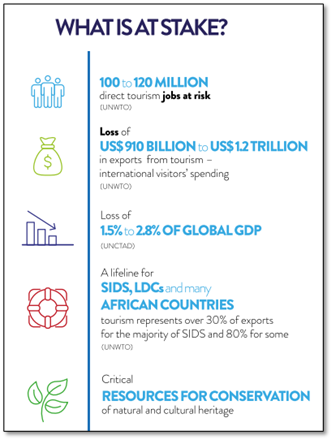
Conclusion
- The pandemic has once again exposed structural shortcomings in the tourism system and the vulnerability to external shocks. There is an urgent need to diversify and strengthen the resilience of the tourism economy, to better prepare for future shocks and address long standing structural weaknesses.
- Tourism should be regarded as a key component of economic recovery and should be central to measures designed to revive economic growth because the trade flows generated by a strong tourism industry have a major effect on business and consumer confidence. The development of domestic tourism can significantly stimulate domestic consumption and direct economic activity towards growth that favours indirect impacts on all productive sectors of the economy.
- Though, in times of crisis, many stakeholders doubt the stability of tourism's contribution to GDP, but it is crucial to look at the macroeconomic aggregates, and the way its constituents interact, to understand tourism resilience.
Question: Explain the potential of tourism sector and analyse the impact of Covid-19 on the tourism sector.
Primary Sources: https://www.un.org/sites/un2.un.org/files/sg_policy_brief_covid-19_tourism_august_2020.pdf
https://www.tandfonline.com/doi/full/10.1080/02508281.2020.1846971
https://www.unwto.org/tourism-and-covid-19-unprecedented-economic-impacts
Secondary Sources: http://loksabhaph.nic.in/writereaddata/Updates/EventLSS_637520244037902912_Researchsustaining%20tourism22032021.pdf
https://www.ncbi.nlm.nih.gov/pmc/articles/PMC7528873/
https://www.un.org/en/un-chronicle/tourism-can-help-lead-world-recovery
https://core.ac.uk/download/pdf/82431386.pdf
This Day in History -Berlin Blockade
On June 24, 1948, the Berlin blockade, an international crisis arose from an attempt by the Soviet Union, in 1948–49, to force the Western Allied powers (the United States, the United Kingdom, and France) to abandon their post-World War II jurisdictions in West Berlin. Alarmed by the new U.S. policy of giving economic aid to Germany and other struggling European nations, as well as efforts by the Western Allies to introduce a single currency to the zones they occupied in Germany and Berlin, the Soviets blocked all rail, road, and canal access to the western zones of Berlin. Suddenly, some 2.5 million civilians had no access to food, medicine, fuel, electricity, and other basic goods. Eventually, the western powers instituted an airlift that lasted nearly a year and delivered vital supplies and relief to West Berlin. The Berlin Blockade, and the Allied response in the form of the Berlin Airlift, represented the first major conflict of the Cold War.

Sources: https://www.history.com/topics/cold-war/berlin-blockade
https://www.britannica.com/event/Berlin-blockade
Image of the Day -Pygmy Hog
This is the image of captive-bred pygmy hogs, the world’s rarest and smallest wild pigs, who were released in the Manas National Park of western Assam. The reintroduction programme, Pygmy Hog Conservation Programme (PHCP), began in 2008 with the Sonai-Rupai Wildlife Sanctuary, Orang National Park and Barnadi Wildlife Sanctuary. Conservation of pygmy hog was initiated by noted naturalist Gerald Durrell and his trust in 1971. Pygmy hog was brought back from near extinction by the partnership effort, and now we are moving towards the establishment of a population across the entire range. Pygmy hog is currently listed as ‘Critically Endangered’ on the IUCN Red List of Threatened Species.
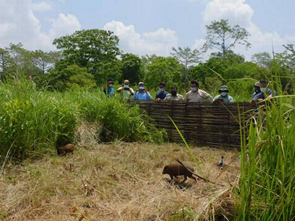
First-ever Genetically Modified Rubber Planted in Assam
- Context: development of GM rubber plant to handle the local cold climatic conditions of the Northeast India.
- This GM rubber has copies of the gene MnSOD, or manganese-containing superoxide dismutase, inserted in the plant, which is expected to tide over the severe cold conditions during winter - a major factor affecting the growth of young rubber plants in the region.
- The plant was developed at the Kerala-based Rubber Research Institute of India (RRII).

Primary source: https://www.thehindu.com/news/national/other-states/first-ever-genetically-modified-rubber-planted-in-assam/article34901294.ece
Picture source: https://www.britannica.com/science/rubber-chemical-compound/Tapping-and-coagulation
4th Tiger Reserve in Rajasthan
- Context: Ramgarh Vishdhari Wildlife Sanctuary to become the 4th Tiger Reserve of Rajasthan.
- This Sanctuary is located at Bundi district, Rajasthan. It becomes the 52nd Tiger Reserve of India.
- It comprises of hilly dry deciduous forests on Vindhyan formations.
- Other Tiger Reserves in Rajasthan include: Ranthambore Tiger Reserve in Sawai Madhopur, Sariska Tiger Reserve in Alwar and Mukundra Hills Tiger Reserve in Kota.

Primary source: https://allaboutindia.info/tourism/attractions-in-bundi/ramgarh-vishdhari-wildlife-sanctuary/
Picture source: https://en.wikipedia.org/wiki/List_of_districts_of_Rajasthan
Presidio Principles
- Context: World Economic Forum announces Presidio Principles as a foundation of blockchain ecosystem design.
- The “Presidio Principles: Foundational Values for a Decentralized Future” is an initiative by WEF’s Global Blockchain Council for those building blockchain technology and decentralized infrastructure.
- These guidelines are for organizations which are building systems atop data and components which might not have a central coordinator.
- These principles are divided into four categories of rights for participants:
- Transparency & Accessibility
- Agency & Interoperability
- Privacy & Security
- Accountability & Governance
Primary source: https://www.lexology.com/library/detail.aspx?g=0f801fdd-d546-48cd-88a9-9ff86766c16a
https://github.com/WEF-Blockchain/Presidio-Principles
New Doppler Radars in Maharashtra
- Context: Indian Meteorological Department has planned to install seven new Doppler radars in Maharashtra.
- Doppler Radar is a specialized radar that uses the doppler effect to produce velocity data about event/objects at a distance.
- Doppler radars of varying frequencies - S-band, C-band and X-band are commonly used by the IMD to detect and track the movement of weather systems, cloud bands and gauge rainfall over its coverage area of about 500 km.
- The radars guide meteorologists, particularly in times of extreme weather events like cyclones and associated heavy rainfall. An X-band radar is used to detect thunderstorms and lightning whereas C-band guides at the time of cyclone tracking.
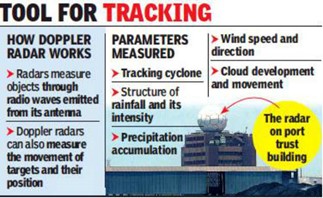
Primary source: https://indianexpress.com/article/india/imd-radar-network-maharashtra-7370952/
Picture source: https://timesofindia.indiatimes.com/city/chennai/citys-doppler-radar-not-fully-functional/articleshow/66396215.cms
India needs a third generation of reforms-HT
Essence: In India’s development journey, two major policy departures in its approach to growth and development stand out. We are at a similar crossroads, and it is time to usher in a third generation of reforms. In this context, the article while drawing lessons from earlier reforms suggests empowerment of the public sector to deliver growth-enhancing public goods and services for the benefit of all segments of the public, private sector, and corporate entities alike.
Why you should read this article?
- Have a brief background on first and second generation reforms and their understand major criticisms.
- Identify the broad contours of third generation reforms such as significantly improving both the quality and scale of public services, enhancement of government’s own technocratic competence and implementation capacity, enhancement of investment levels, setting up growth-promoting governmental institutions while also incentivising the private sector among others.
Article Link: https://www.hindustantimes.com/opinion/india-needs-a-third-generation-of-reforms-101624449223050.html
The gender technology gap has to end-TH
Essence: According to various reports, millions of women in low and middle-income countries do not have Internet access. In India, this divide is deepened during Covid pandemic to get a vaccination appointment. To tackle this, we need to change our mindset around digital technology and device ownership by changing our belief that women’s access to technology will motivate them to challenge patriarchal societies and online content are dangerous for women. There are several steps taken at national and international levels to encourage equal participation of females in technology and innovation and closing gender gap. This would increase GDP over next few years as women and girls are the largest consumer groups left out of technology.
Why you should read this article?
- To get an overview of issue related to gender technology gap and how Covid 19 pandemic has highlighted this?
- To understand the reasons behind this widening gender technology gap.
- To know where India stands and what possible should be taken to tackle this issue.
Article Link: https://www.thehindu.com/opinion/lead/the-gender-technology-gap-has-to-end/article34939814.ece
Hero Teacher Single-Handedly Dispels Fake News, Helps Vaccinate 10,000 Others
Background:
- Residents of village used to run away when health workers knocked their doors for the COVID-19 vaccination drives.
- Villagers showed extreme vaccine hesitancy fearing death and other misconceptions.
- When Zilla Parishad (ZP) schoolteacher, Ratan Chaudhari visited his native for the first time since the countrywide vaccination drive began, he learned that hardly any person in the village had taken the vaccine.
Task of creating awareness:
- Since then, Ratan Chaudhari is clearing misconceptions to reduce vaccine hesitancy among the villagers as he realised the main problem was due to misinformation.
- Villagers feared vaccination would cause death or infertility. Deaths in the neighbouring states fuelled their misconception.
- Misconception kept on increasing as the villagers spoke in local language Dangi and Konkani and government announcements were made in Marathi
Home is the place where the change begins:
- Ratan Chaudhari started from his home, convinced his father Shivram to take the vaccine
- He then shared the example of his father to dispel fears among villagers.
- He started reaching out to people at weddings, funerals, a village chowk, bus stop, temples, and farms to talk about the importance of the vaccination
- He bought masks and handed them out to people to start a conversation.
- He translated the leaflets from Marathi to the local languages and shared the messages on WhatsApp and other social media among the community.
- Slowly, villagers felt convinced and started taking the vaccine.
Output:
- In April, around 2,500 people were vaccinated which has now jumped to 13,156 in June
Things to ponder:
- How to become an agent of change, innovative steps to curb vaccine hesitancy, importance of local language in communication and in administration.
Share the article
Get Latest Updates on Offers, Event dates, and free Mentorship sessions.

Get in touch with our Expert Academic Counsellors 👋
FAQs
UPSC Daily Current Affairs focuses on learning current events on a daily basis. An aspirant needs to study regular and updated information about current events, news, and relevant topics that are important for UPSC aspirants. It covers national and international affairs, government policies, socio-economic issues, science and technology advancements, and more.
UPSC Daily Current Affairs provides aspirants with a concise and comprehensive overview of the latest happenings and developments across various fields. It helps aspirants stay updated with current affairs and provides them with valuable insights and analysis, which are essential for answering questions in the UPSC examinations. It enhances their knowledge, analytical skills, and ability to connect current affairs with the UPSC syllabus.
UPSC Daily Current Affairs covers a wide range of topics, including politics, economics, science and technology, environment, social issues, governance, international relations, and more. It offers news summaries, in-depth analyses, editorials, opinion pieces, and relevant study materials. It also provides practice questions and quizzes to help aspirants test their understanding of current affairs.
Edukemy's UPSC Daily Current Affairs can be accessed through:
- UPSC Daily Current Affairs can be accessed through Current Affairs tab at the top of the Main Page of Edukemy.
- Edukemy Mobile app: The Daily Current Affairs can also be access through Edukemy Mobile App.
- Social media: Follow Edukemy’s official social media accounts or pages that provide UPSC Daily Current Affairs updates, including Facebook, Twitter, or Telegram channels.

